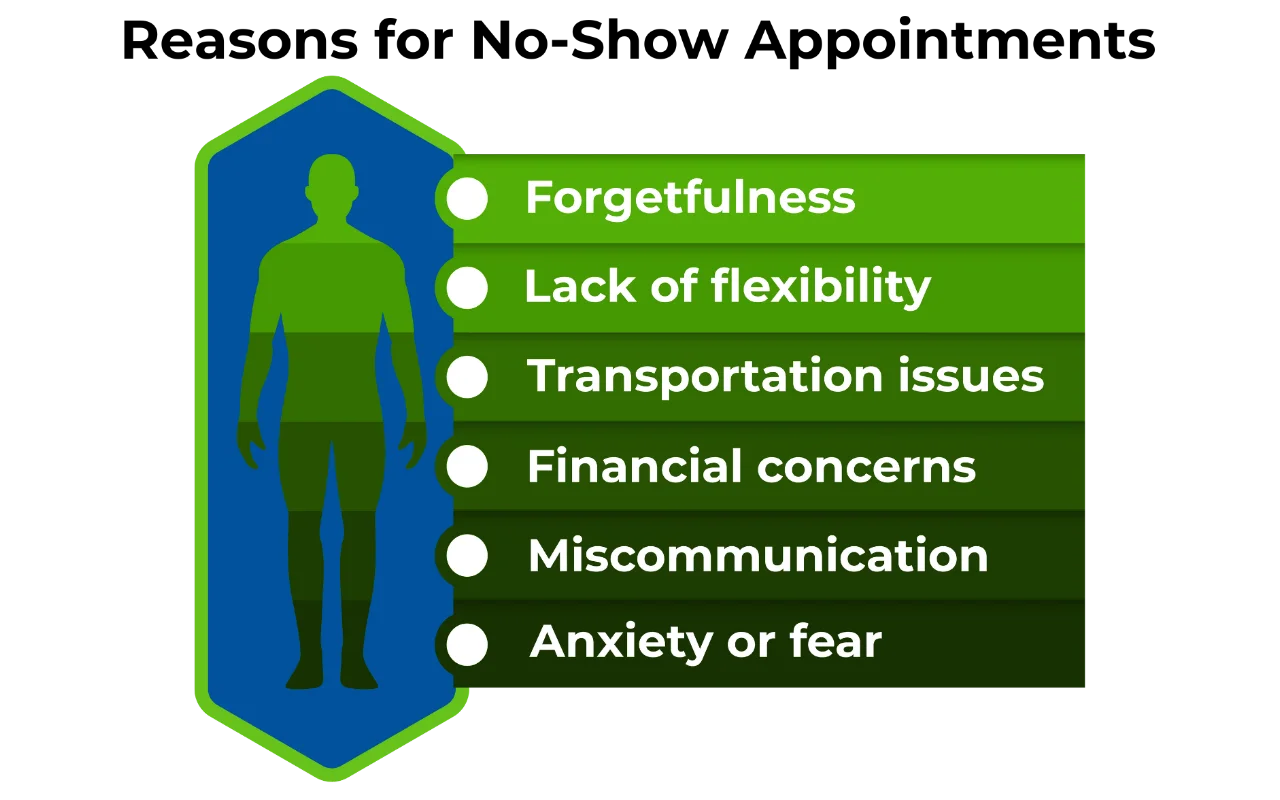Key Takeaways
- No-shows disrupt workflows and cost the healthcare industry billions annually.
- Patient portals reduce no-shows with reminders, scheduling, and secure communication.
- Portals also improve admin tasks, compliance, and patient satisfaction.
- Learn how to maximize your patient throughput with our revenue guide.
You’ve always prided yourself on running a well-organized and patient-focused practice. But, like many providers, you probably feel frustrated by the ongoing challenge of no-show appointments. Patients who miss their scheduled visits disrupt your workflow, leave open slots that could have been used to see others, and compromise continuity of care.
However, missed appointments aren’t just an inconvenience. One study reveals that no-show rates in outpatient settings range from 15% to 30%, costing the US healthcare system billions annually.
Addressing no-shows requires a proactive approach—one that prioritizes patient engagement and modern tools to facilitate smoother communication. Let’s dive into how to reduce no-show appointments.
Table of Contents
Why Do No-Show Appointments Happen?
Patients miss appointments for a variety of reasons, many of which can be addressed with the right tools and strategies. Here are some common causes:
- Forgetfulness: Life is busy, and appointments can slip through the cracks, especially without timely reminders.
- Lack of flexibility: Patients often struggle to reschedule when their availability changes, leading them to skip appointments altogether.
- Transportation issues: Some patients, particularly those in rural or underserved areas, face challenges getting to their appointments due to unreliable transportation.
- Financial concerns: Concerns about co-pays or treatment costs can discourage patients from showing up, especially if they haven’t been informed of their financial responsibilities beforehand.
- Miscommunication: Patients might misunderstand appointment details, such as date, time, or location, particularly if the practice doesn’t provide clear and consistent communication.
- Anxiety or fear: Some individuals avoid appointments due to anxiety about medical procedures or receiving bad news.
Understanding these reasons is the first step in reducing no-shows. By addressing these barriers head-on, practices can foster better engagement and reliability from their patients.

How Patient Portal Software Helps Reduce No-Show Appointments
1. Improved Communication
With patient portal software, your practice can maintain direct and real-time communication with patients. Automated reminders, appointment confirmations, and rescheduling options make it easier for patients to stay on top of their appointments. Practices leveraging these tools not only improve patient satisfaction but also drastically cut down on no-shows.
2. Enhanced Patient Self-Service
Patients can use the portal to:
- Schedule or reschedule appointments.
- Update demographic and insurance information.
- Submit their medical history and other required forms.
When patients actively engage in these tasks through a patient portal, they are more likely to attend scheduled appointments because they have invested time in the process and received timely reminders.
3. Secure and Convenient Access to Information
Patient portal software allows patients to:
- View their upcoming appointments.
- Receive test results and follow-up instructions.
- Send secure messages to the practice.
- Print information for their own records.
These features not only enhance the overall patient experience but also ensure they are better informed and prepared for their visits, reducing the likelihood of missed appointments.
4. More Self-Managed Care
Patient portals enable patients to take more agency over their health by:
- Providing digital versions of important care-related information.
- Reminding patients of their care instructions.
- Engaging patients with follow-up reminders.
As individuals become more empowered to manage their care journeys, they’re more likely to understand the importance of routine visits and grasp why attending their appointments is vital to their well-being.
WRS HEALTH CLIENT
“Patients are becoming more informed about their healthcare. They can get into the WRS patient portal and make changes and get some of their health history completed before they come in. The other thing that is wonderful about the patient portal is that many times when patients leave the office they’ve had so much information given to them. Along with our diagnoses, there are patient instructions that go to the patient portal. When patients get home they can look at those instructions, print them out and get a more in-depth understanding of their treatment plan.”
Toni Pratt-Reid, APRN
Family Healthcare & Minor Emergency Clinic, Inc.
Beyond Reducing No-Shows: Other Benefits of Patient Portal Software
Adopting patient portal software offers more than just a reduction in no-show appointments. It also optimizes administrative processes, saving your staff countless hours and reducing operational costs. Here are some additional advantages:
- Improved efficiency: Staff spend less time on manual tasks, such as data entry and phone calls.
- Better compliance: Patient portals can help ensure meaningful use compliance.
- Increased patient satisfaction: Empowering patients with self-service options fosters a positive and effective experience.
Minimize No-Shows for a Successful Practice
Reducing no-show appointments doesn’t require a complete overhaul of your processes. Implementing patient portal software is an easy step toward improving patient engagement, enhancing communication, and reducing wasted time. Start exploring solutions that work for your practice today.





 QUICK CHARTING
QUICK CHARTING NOTE
NOTE MEDICATION
MEDICATION PATIENT
PATIENT BILLING
BILLING RISK
RISK MARKETING
MARKETING MIPS
MIPS